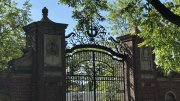During the pandemic recession, it has been amazing to read regular Boston Globe reports about eight- and nine-figure venture-capital investments in biomedical start-ups, and oversubscribed initial public offerings for medical and biotech enterprises. There is money aplenty for the sector, it seems.
Not coincidentally, developers continued making deals at a torrid pace to site new labs. During the first week of July, Alexandria Real Estate Equities and National Development paid $33 million to buy a six-acre tennis center in Watertown, the Globe reported—half a year after Alexandria bought the athenahealth campus on Arsenal Street for more than a half-billion dollars. Two days later, the paper reported, life-sciences developer IQHQ paid $125 million for an office building and land, totaling 26 acres, near the Alewife MBTA terminus in North Cambridge.
What has all this to do with the University? On one level, it evokes a private-market echo of former President Lawrence H. Summers’s vision, earlier this millennium, for a 10-million-square-foot Harvard life-sciences research campus in Allston: a mega-billion plan that imploded before the Great Recession. It also recalls the late-2009 decision to “pause” construction of the science complex along Western Avenue (see harvardmag.com/allston-plans-delayed-09). Come this winter, a full 12 years later, that redesigned science and engineering center (SEC) will be ready for faculty, staff, and students, assuming no further coronavirus complications. On that front, then, things have finally progressed.
Rather than being caught mid-construction by this health and financial upheaval, and the resulting tightening of Crimson belts, other major Allston projects are still on the drawing boards. Fundraising and design continue for the new American Repertory Theater, on North Harvard Street (described at harvardmag.com/artallston-architect-19). Development of the planned enterprise research campus (ERC) is a joint undertaking between Harvard Allston Land Company and Tishman Speyer; the latter presumably bears the risk of bringing forward the hotel-conference center, office-lab buildings, and residential towers envisioned on the initial parcel, across from Harvard Business School (see harvardmag.com/allston-developer-19).
If the ERC proceeds, it might become a reality around mid decade: about 40 years after Harvard began buying land in Allston. It might be timely, before then, to take stock of where the University thinks it is headed.
Because the SEC had to be redesigned to become affordable, there is space atop the same enormous subsurface platform (now landscaped) for a companion facility. But given the likely billion-dollar-plus cost and the current search for capital spending to defer or eliminate, don’t hold your breath. Longer term, the major play is the 22 acres beyond the initial ERC development. The far frontier is the approximately 100-acre parcel beyond that. Those phases await the state’s reconstruction of the Massachusetts Turnpike viaduct: potentially a billion-dollar, decade-long project of pharaonic scope and complexity.
A nearly 400-year-old institution might reasonably take all this in stride. It took multiple administrations to buy and clear the land, secure permits, and build some stuff. Harvard endureth. Who knows what it might build in Allston a century hence?
But holding on for some long-term unknown is not necessarily Harvard’s only, or best, option. As noted, absent the University’s grandiose biomedical building plans, the local life-sciences ecosystem—in which Harvard researchers play essential roles—seems to be coping just fine. Adept developers are creating huge nodes of lab space far beyond the pricey epicenter at Kendall Square: in Watertown, in every direction from Alewife (where the presence of the T is an advantage, once people resume commuting), downtown (at the GE headquarters site, for instance), and along the suburban Route 128 corridor. Harvard’s competitive advantage is not immediately apparent.
Another consideration is that the University could use the money. For all its improvements in financial management and liquidity since 2008, its faculties overall have not grown. Right now, when talented scholars are graduating into a terrible job market and the University might scoop up the leading professors of the future, it has frozen searches: a real intellectual cost. Important, planned projects are being shoved to the back burner. Both the endowment and executive education are constrained (see harvardmag.com/covid-onlineschools-distributiondown-20 and harvardmag.com/exec-ed-losses-20). Only a Harvard could have, for decades, invested a couple of billion dollars (conservatively) on vacant Allston land and obsolete buildings, planning, site work, community benefits, and initial construction. Some of those funds might come in handy about now.
Finally, what are the greatest needs to keep Greater Boston and the University vibrant now and in the future? For government officials, the priorities are probably transportation and K-12 (or earlier) education. For everyone else, it is building more housing. The struggling Boston of 50 years ago has boomed (at least until the pandemic)—but is a frightfully expensive place to live. If future teaching and labs require less space, and the engineering buildings being emptied in Cambridge are recycled efficiently, perhaps Harvard needn’t bank all its laboriously assembled Allston property for academic use—and other uses might be better realized by developers.
Imagining a way to realize the value of Harvard’s land, encumbered for a decade or more, is highly spectulative. But now seems a good time to reassess. Assembling Allston, and envisioning Harvard extended there, have preoccupied University leaders for more than a generation. Looking toward Harvard’s fifth century, that goal might well loom smaller than it does today. As the pandemic overturns expectations of every sort, perhaps it has created an opportunity: to step back, take stock, and even reconceive the Allston agenda, before making further, inflexible commitments.
~ John S. Rosenberg, Editor








